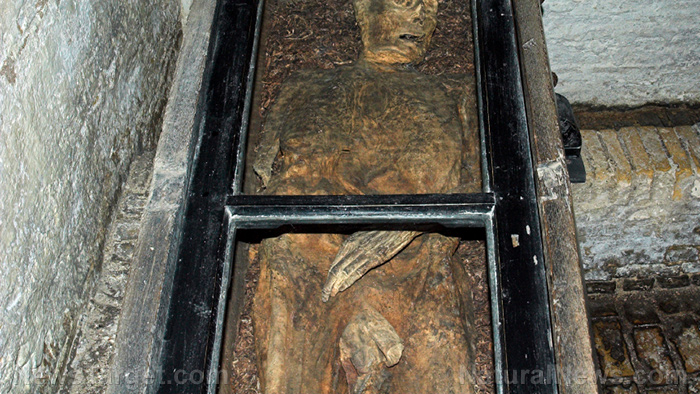 Parler
Parler Gab
Gab
- Two 7,000-year-old mummies in Libya’s Sahara reveal a previously unidentified genetic group that split from other Africans 50,000 years ago and remained isolated, challenging migration theories.
- Despite living during a fertile period, the mummies — female pastoralists — show no ancestral ties to sub-Saharan Africans, Middle Easterners or Europeans, instead linking to ancient Moroccan hunters.
- Archaeological evidence suggests the group adopted herding and tools from outsiders but maintained genetic purity, defying assumptions of the Green Sahara as a melting pot.
- The group’s prolonged isolation suggests environmental or cultural barriers limited gene flow, highlighting the Sahara’s role as a "cultural island" with unexpected complexity.
- The lineage’s traces persist in modern North Africans, but its origins and reasons for isolation remain unclear, emphasizing Africa’s understudied role in human evolution.
Discovery reveals a “ghost” population in Africa’s deadliest desert
The two mummified individuals, buried in Takarkori rock shelter, were female pastoralists who lived during the climatic peak of the “Green Sahara,” a 10,000-year era when the desert teemed with lakes, grasslands and abundant wildlife. Despite the Sahara’s fertile past, the research team found that these individuals shared no detectable genetic ties to sub-Saharan Africans or migrating populations from the Middle East or Europe. Instead, their DNA closely aligned with Ice Age hunters from Morocco, forming a lineage that had diverged from all other Africans 50,000 years prior. “This was a population that probably didn’t even realize how isolated they were,” said study co-author Nada Salem, an archaeogeneticist at the Max Planck Institute for Evolutionary Anthropology. The team’s sequencing of the mummies’ full genomes, published in Nature, exposed a genetic group that researchers had only previously detected as faint “ghost” signals in modern North Africans.The Green Sahara: A crossroads without cultural exchange?
The discovery upends ideas about the Green Sahara as a melting pot. For decades, scientists assumed its lush environment facilitated interactions between African, European and Middle Eastern groups, with farming practices like herding spreading through migration. However, the Takarkori women’s genomes — lacking Levantine or Eurasian ancestry — suggest that agricultural practices such as livestock herding were absorbed through cultural exchange, not mass population movements. “Their tools, pottery and even herding methods were adopted from outsiders, but there was little intermarriage,” explained Johannes Krause, the study’s senior author. “They’re like living fossils, clinging to their ancestral root until the Sahara dried up.” The mummies’ DNA also contained traces of Neanderthal ancestry — about one-tenth of what non-Africans of the era carried — hinting that their ancestors may have interacted with Neanderthals earlier, but kept their genetic makeup remarkably stable for tens of millennia.Rewriting the rules of human migration and isolation
The Takarkori lineage’s long isolation reshapes assumptions about ancient human behavior. “They were in a prime location for interaction but chose — or were forced by environment — to stay separate,” said Salem. Their genetic uniqueness suggests the Sahara’s varied landscapes, from wetlands to scrubland, acted as barriers to connectivity, even during its greener millennia. The findings also underscore the Sahara as a place of unexpected complexity. While the Green Sahara’s productivity supported thriving communities, its resources may have allowed groups to remain self-sufficient without exchanging genes. “It’s like a cultural island,” said Krause. “They absorbed ideas but kept their bloodline pure.”Legacy in modern populations and future questions
Though the Takarkori group no longer exists in its original form, its genetic traces persist in modern North Africans, contributing significantly to local heritage. The study highlights how Africa’s role in human evolution is still emerging, with its interior largely unstudied due to sparse fossil records. Yet mysteries remain. Researchers cannot pinpoint where the lineage lived before the Green Sahara’s rise — 50,000 years of history “in the dark,” Krause says — and why such isolation endured.The mummies' message for modern tribes of humankind
The Takarkori mummies’ tale shows how humans can shape culture without mixing bloodlines, offering fresh perspective on how innovation spread across the ancient world. Their genes, like the Sahara’s shifting sands, remind us that our shared history is far more fractured—and fascinating — than we knew. As the desert reclaims their secrets, scientists are racing to uncover the next hidden threads in humanity’s intricate tapestry. “Every fossil is a piece of a puzzle we didn’t even know existed,” Krause said. “There’s still a billion stories buried under the dunes.” Sources include: DailyMail.com ScienceFocus.com PopularMechanics.comStudy: Daily soda habit linked to 5x higher risk of ORAL CANCER in women
By Ava Grace // Share
Seven herbs and supplements for heart failure
By News Editors // Share
Study: The gut could be the key to early autism detection in toddlers
By Olivia Cook // Share
White House admits to Wuhan lab leak as Fauci’s credibility crumbles in historic scandal
By Lance D Johnson // Share
Governments continue to obscure COVID-19 vaccine data amid rising concerns over excess deaths
By patricklewis // Share
Tech giant Microsoft backs EXTINCTION with its support of carbon capture programs
By ramontomeydw // Share
Germany to resume arms exports to Israel despite repeated ceasefire violations
By isabelle // Share










